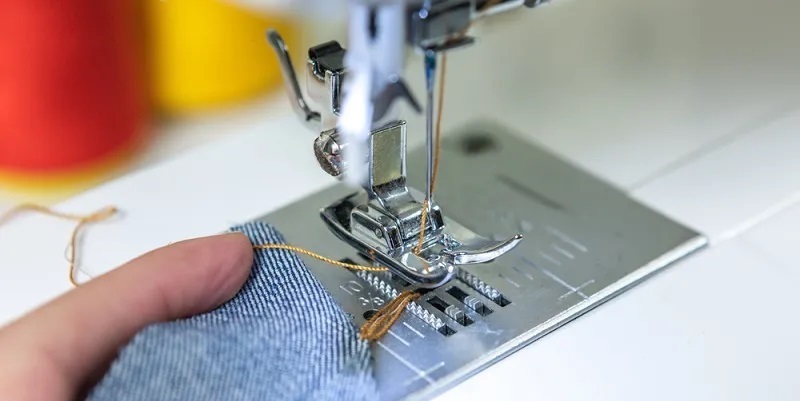Reasons Why Your Sewing Machine Is Jamming and How to Fix
1st Jun 2023
Why Does My Sewing Machine Keep Jamming?

There’s nothing more frustrating than cheerfully working on a sewing project and suddenly having your work brought to a standstill by a jammed sewing machine! It happens to the best of us, beginners and advanced seamstresses alike. The key is identifying the issue so that you can fix it and get on with your project.
Below, we outline 5 of the most common reasons that your sewing machine keeps jamming — plus, how to fix it.
5 Reasons Why Your Sewing Machine is Jamming
Sewing machine jamming is actually a relatively common problem since it can be a symptom of quite a few different issues. These five are the most likely culprits for causing your sewing machine to jam.
1. Your machine is threaded incorrectly.
If your sewing machine is not threaded correctly, it can cause all sorts of issues — including jamming. The most likely issue is the top thread; if you miss a tension disk, the thread will not have enough tension applied to it, allowing it to cause a tangled mess and eventually bring your machine to a complete halt.
2. Your thread tension is not set correctly for the fabric.
Speaking of tension — if your tension is not at the correct setting for the fabric you are working with, it may cause your sewing machine to jam. Every fabric will work best at a certain thread tension, so you should reevaluate your tension settings each time you start a project with a new fabric to find the right setting for that fabric.
3. Your needle is bent, broken or dull.
One of the most common reasons for a sewing machine to keep jamming is a damaged or dull needle. If the needle is bent, it may be hitting the presser foot or throat plate instead of going through the fabric. If it’s broken or dull, it will not work properly and may cause thread tangles or not make it through the fabric at all. You’ll also want to ensure that you’re using the right needle for the fabric — you’ll experience issues if your needle is the wrong size or type.
4. Lint and debris are clogging up your sewing machine.
We’ve all been there — avoiding taking apart and cleaning out the sewing machine so we can start the next project. But cleaning your machine regularly is pretty important! A dirty machine can cause all sorts of issues, including jamming. Having lint, thread pieces or other debris stuck in the bobbin area, the feed dogs or the tension disks can really wreak havoc on your machine’s stitch quality and even cause it to stop working completely.
5. You’re using low-quality thread.
I’m sure you’ve heard that “you get what you pay for” — that’s true for thread as well. Low-quality thread often tends to fray, break and tangle. It can even cause a buildup of lint in your bobbin area or upper thread tension disks. A lower quality thread often sheds lint and doesn’t hold up as well as a quality thread to the pressure of being pulled through a sewing machine.
How to Fix Your Jammed Up Sewing Machine
Identifying the cause of your sewing machine jamming is only a small part of the solution; the most important thing is fixing the problem!
The steps below will help you to fix your jammed sewing machine and get back to working on your project.
Rethread your machine properly again.
The very first thing to do when you’re experiencing any sort of issue with your machine, including jamming, is to rethread the machine. As you rethread, double check to ensure that the thread is properly inserted between the tension disks. It may even help to clean out the tension disks with a little brush during the process.
Check your thread tension.
Make sure your tension, especially your upper thread tension, is set correctly for the fabric you are working with. It works best to experiment with different tension settings on scrap pieces of fabric until your machine is sewing nice, even stitches and is not jamming.
Check your needle for damage.
Make sure to carefully look over the needle in your sewing machine. If it looks at all bent or broken, you’ll want to swap it for a fresh needle. Also, if you’ve been using the same needle for several projects, it’s probably dull! You’ll need a new, sharp needle. It’s also good to double check that you’re using an appropriately sized needle and the right type for your fabric. For example, if you’re sewing a stretch fabric, make sure you’re using a stretch needle.
Clean your sewing machine.
It’s good to get into the habit of cleaning your sewing machine regularly. But if you haven’t cleaned it in a while and you’re experiencing issues, it’s definitely worth the effort to clean your machine. Using a small brush or a mini vacuum attachment, clean the upper thread tension disks. Then take the throat plate off your machine and clean out the bobbin area thoroughly.
Switch to higher quality thread.
If you’ve been using inexpensive thread, try switching to a higher quality brand or type of thread. Premium, top-notch thread won’t clog up your machine with lint. You can shop for different types of high-quality threads for embroidery, quilting or other projects, even when sewing with heavy cotton threads, on Premier Stitching.


